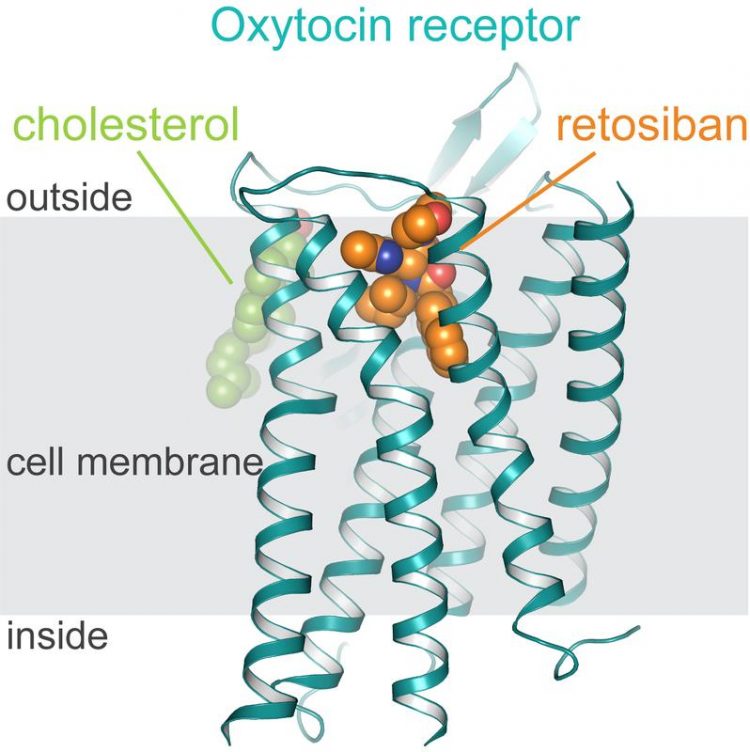Blueprint of Oxytocin Receptor Facilitates Development of New Autism Drugs

Structure of the oxytocin receptor in the cell membrane (grey), to which retosiban (orange) and cholesterol (green) are bound. University of Zurich
The so-called “love hormone” or “cuddle hormone” oxytocin is not only involved in strengthening the mother-child relationship and regulating social bonding. It also plays an important role in different mental health disorders like autism, Asperger's syndrome, social anxiety or addiction vulnerability.
Furthermore, oxytocin starts labor, the birth process, and features in many aspects of sexual reproduction – as well as corresponding disorders.
The hormone exerts all these effects by binding to the oxytocin receptor. Substances that target the oxytocin receptor thus have great therapeutic potential for a variety of diseases.
New drugs are difficult to develop
Since its discovery nearly 30 years ago, researchers have tried to develop drugs that bind specifically to the oxytocin receptor. However, conducting such experiments proved to be very difficult.
Except for the hormone oxytocin itself, hardly any drug targeting the oxytocin receptor has been approved for clinical use. A team led by Andreas Plückthun, professor at the Department of Biochemistry of the University of Zurich (UZH), has now determined the detailed three-dimensional structure of the oxytocin receptor bound to the drug candidate retosiban, which was developed for the suppression of preterm labor.
“The elucidation of the oxytocin receptor's structure was an extremely challenging undertaking, which only succeeded thanks to a combination of directed evolution and protein engineering methods we developed over the last few years,” says Plückthun.
“Understanding the exact three-dimensional interaction of retosiban and the oxytocin receptor at the atomic level serves as the blueprint for developing new therapeutics that regulate the receptor's functioning.”
Improved understanding of receptor mechanism
The scientists also made an additional discovery. “To allow efficient propagation of oxytocin-induced signaling, the oxytocin receptor has to interact with two additional substances – cholesterol and magnesium,” says PhD candidate Yann Waltenspühl.
Determining the exact receptor shape enabled the researchers to identify interaction regions for both of these substances. “The identification of these previously unknown regions fundamentally improves the understanding of the receptor mechanism,” adds the first author of the study.
Boosting the development of new therapeutics for other diseases
The new findings might also be directly applicable to the very closely related vasopressin receptors. The hormone vasopressin controls the water content of body fluids and the blood pressure, and its receptors are therefore drug targets for the treatment of many diseases – from kidney disease to heart failure.
Just like the oxytocin receptor, the vasopressin receptors have also been implicated in autism spectrum disorders. “Our work could thus boost the development of new drugs for a very broad range of widespread and severe human diseases,” concludes Andreas Plückthun.
Prof. Dr. Andreas Plueckthun
Department of Biochemistry
University of Zurich
Phone: +41 44 635 55 70
E-mail: plueckthun@bioc.uzh.ch
Yann Waltenspühl, Jendrik Schöppe, Janosch Ehrenmann, Lutz Kummer, Andreas Plückthun. Crystal structure of the human oxytocin receptor. Science Advances. 15 July 2020. DOI: 10.1126/sciadv.abb5419
https://www.media.uzh.ch/en/Press-Releases/2020/Oxytocin-Receptor.html
Media Contact
All latest news from the category: Life Sciences and Chemistry
Articles and reports from the Life Sciences and chemistry area deal with applied and basic research into modern biology, chemistry and human medicine.
Valuable information can be found on a range of life sciences fields including bacteriology, biochemistry, bionics, bioinformatics, biophysics, biotechnology, genetics, geobotany, human biology, marine biology, microbiology, molecular biology, cellular biology, zoology, bioinorganic chemistry, microchemistry and environmental chemistry.
Newest articles

Pinpointing hydrogen isotopes in titanium hydride nanofilms
Although it is the smallest and lightest atom, hydrogen can have a big impact by infiltrating other materials and affecting their properties, such as superconductivity and metal-insulator-transitions. Now, researchers from…

A new way of entangling light and sound
For a wide variety of emerging quantum technologies, such as secure quantum communications and quantum computing, quantum entanglement is a prerequisite. Scientists at the Max-Planck-Institute for the Science of Light…

Telescope for NASA’s Roman Mission complete, delivered to Goddard
NASA’s Nancy Grace Roman Space Telescope is one giant step closer to unlocking the mysteries of the universe. The mission has now received its final major delivery: the Optical Telescope…



